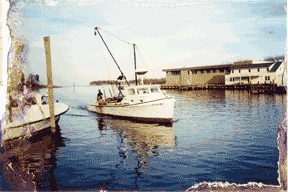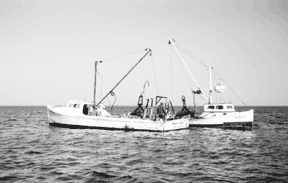|
|
 |
|||||||||
|
||||||||||
Is There Still a Pearl in Maryland’s Oyster?This year, Chesapeake oystermen averaged $6,666 for six months of cold, backbreaking work.story and photos by Mick Blackistone
|
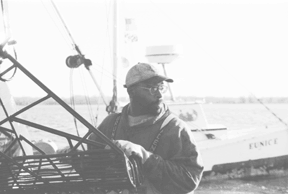 |
‘We’ll have a decent season … if there are plenty of good, healthy oysters … if the boat and gear don’t break down … if ice doesn’t freeze us up … if the wind doesn’t blow us off the water … and if the market holds up. That’s a lot of if’s, ain’t it?’– Fourth-generation waterman J.R. Gross |
To make sure oystering stays on an even keel for everyone, Gross also chairs the Anne Arundel County Tongers’ Committee, which works as part of the State Oyster Committee to advise the Department of Natural Resources on policy and regulations regarding oyster harvests.
“We’ve lost a lot in terms of oyster production due to overharvesting, disease and pollution. And we’ve lost a lot of jobs and a lot of money for the state. I’m not sure we’ll ever get it back,” says Gross, who routinely comes in off the water to spend hours in meetings or on the telephone with state officials and Simns, Evans and other watermen to discuss how to handle regulatory or legislative initiatives.
They attend formal state meetings, testify at state and local hearings and keep in communication with elected officials who can influence the outcome of a particular bill or regulation.
“Regulations are supposed to protect the Bay’s declining oyster population from extinction yet still meet the public demand and provide an income for watermen and other seafood businesses,” Evans explains. “The regulations work for watermen if they sustain both longterm fisheries and livelihoods.”
Most oyster regulations pertain to harvest locations, catch limits, gear types, size restrictions and the days and hours men can work. All that is in constant flux.
“Someone always wants to tweak a regulation or introduce a new law to take one more step in protecting the resource,” Evans says. “We have to stay on top of every idea that’s thrown out there to make sure it’s doable and makes sense.”
Gross has worked for years, he explains, “to try to change the regulations a little so that we could work on Saturdays to increase our limit and income just through the holidays and the Super Bowl, when the market is the hottest.”
So hot that Evans — who buys and sells oysters at Bob Evans Seafood in Churchton — can’t satisfy the demand.
“Before Redskins, Ravens, Maryland games or the Super Bowl, oysters were sold fast and furious to customers who wanted them either shucked or in the shell, by the pint, dozen or bushel. Whatever they could get their hands on they would take,” says Evans. “I would move 15 to 20 bushels a week out of here.”
Things die down after the Super Bowl.
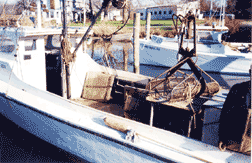 |
Patent tongers like Calvin ‘Pee Wee’ Matthews, below, and his partner J.R. Gross, above, pull oysters from the Bay’s bottom with a hydraulic-powered rake, above, while making sure the iron tongs don’t swing into a waiting forehead. |
 |
So, says Gross, “If we could work Saturdays until then, I could put enough money away to carry me into spring.”
That little change certainly makes sense, but it’s never happened.
“I could never get the thing changed,” Gross says. “So when we’re iced in or blown off during February, which will happen, I end up working to make enough for cigarettes and Pampers.”
Watermen work as hard for the oyster as they do for their industry and themselves.
In 1999, watermen sat down with scientists to write the state’s first oyster management plan, to preserve the resource and balance its use. The strategy they agreed on to restore oysters to Chesapeake Bay was to rebuild oyster habitat, stock it with strong, healthy oysters and establish sanctuaries that would provide healthy oysters for the long term. In 2004, the plan was updated.
Since then — indeed, long before — watermen have contributed thousands of boat- and man-hours to help scientists and environmentalists restore the vitality of the native oyster.
“We took a lead role in creating the Oyster Recovery Partnership, which has done an incredible job in oyster replenishment by planting over 866 million disease-free seed oysters on oyster shell beds at 37 different Bay locations,” Simns says. “We’ve taken a proactive role partnering with Maryland and Virginia to revitalize this fishery.”
Working for the Pearl
There are many ways to oyster, but none of them are easy. Hand-tongers pull up oysters from shallow water with long wooden rakes while standing precariously on the washboard of their boats. Patent tongers like Gross and Matthews use the tong rake, powered by hydraulics, to lower, open, close and lift oysters from the bottom while making sure the iron tongs don’t swing into a waiting forehead. Divers wear insulated suits and breath through airlines while they chisel oysters off reefs and into their baskets. Power-dredgers drag a metal-toothed mesh basket over the oyster bed and haul in their harvest hydraulically.
Hundreds of oyster bars are open for harvest with regulations determining which bars can be worked according to gear type and oyster productivity.
Hand-tongers and divers work in tributaries and shallow water. Patent-tongers and skipjacks, the power dredge boats, are restricted to the main Bay, very limited portions of a few tributaries and Tangier Sound. Power-dredgers can only work below an imaginary line that stretches from Calvert County on the Western Shore across the Bay to Tilghman Island.
It’s all backbreaking, dirty, dangerous work where muscles burn and clothes are wet and cold from either sweat, saltwater or both.
“It used to be a joke that hand-tongers had small heads and big shoulders,” Evans says. “But some days I swear that must apply to every man or woman who works this water and tries to make a living doing it.”
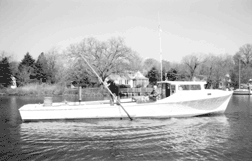 |
Hand-tongers, below, pull up oysters from shallow water with long wooden rakes while balanced on the washboard of their boats. |
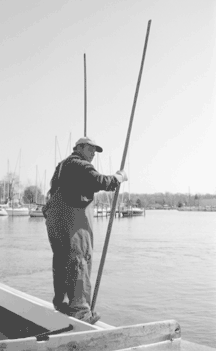 |
Over the past two decades, with oysters in decline, harvests vary greatly from the peak of 1999, when 432,000 bushels were caught by 1,135 watermen for a market value of $7.8 million.
The 2006-’07 season opened October 1 and runs through March 30. As of mid-February, 120,419 bushels were harvested with a market value of $3.3 million.
The total harvest will “probably end up close to last season’s total of 154,355 bushels with a market value of $4.5 million for the 676 licensed oystermen in Maryland,” estimates Chris Judy, Maryland’s shellfish program director at Maryland Department of Natural Resources.
That averages out to $6,666 per license for the entire season.
Worse Luck Next Year
The oyster harvests from 2005 to 2007 may be oases in a stretching oyster desert. Chris Judy expects the harvest for 2007-’08 to decline significantly and the season after to decline again.
“The harvest hasn’t seen a strong seed oyster set in recent years,” he says, “which means according to statewide surveys, oystermen, salinity testing and disease conditions, the near future looks a bit bleak for both watermen and consumers.”
Judy’s a reluctant pessimist. “The oysters that are out there have very good meat and survival rates,” he says. “But disease is still an issue. I would like to be proven wrong on this but I don’t think I will be.”
Bob Evans echoes Judy’s prediction, adding another cause for alarm: oysters reproduce best in wet years with low salinity.
“When you look at the high rainfall over the past year, it’s not a good factor for reproduction,” Evans says. “Then add to that all the salt mounds along the side of the road for snow and ice treatment and consider it will end up in the Bay and bring the salinity levels up, which it will, and we’re not looking to a bright next couple of years.”
The Beat Goes On
Waterman J.R. Gross Jr. — one of a handful of black fulltime watermen, whose father helped form the Maryland Watermen’s Association over 35 years ago — has been involved in or watching the politics and economics of commercial fishing since he was eight years old.
“What we do is support a lot more people and other businesses than just our families,” he said on March 7, look
ing out his window as trees and marsh grass bend in 25-mile-per-hour winds with gusts to 40.
Snow was in the forecast. He couldn’t work and hadn’t for two days. The wind this time, not the ice, kept him and others off the water. Since the first of February, Gross has averaged working three days a week — if he was lucky.
About the AuthorMick Blackistone, of Fairhaven, is an award-winning author of books for children and adults about the Bay and the environment and an activist for watermen and the Bay. He is also consultant, working waterman and lobbyist on maritime and safety issues. His last story for Bay Weekly was this year’s first reflection: “In half a century, both the Bay and I have changed” (Vol. xv, No. 1: Jan. 4). |
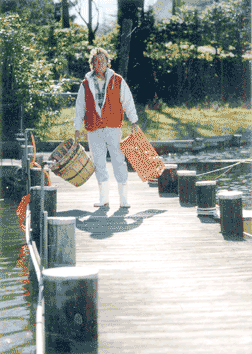 |
There are two weeks left in the season, and neither J.R. Gross nor any waterman needs to be reminded of the predictions for next season. He knows them as well, if not better than, the scientists.
Back in October, Gross weighed the if’s going into the oyster season. He and the other watermen know the truth of Murphy’s Law. If something can go wrong, it will — and usually does — when working the open waters of Chesapeake Bay in the dead of winter. They almost expect it and always try to put money aside so they can confront any outcome of Murphy’s Law head on.
After generations of experience, they don’t dwell on problems with gear, weather, markets, regulation or finances. Their
response is What will be, will be. In an instant, they move to laughing, telling a story, mending gear, moving away from the negative toward new optimism and hope.
So Gross felt relatively at ease as he walked away from the wind and the gusts pushing water up the creek.
“The gear and boat held up. We had good, meaty oysters all season. Most stretches of bad weather held off until February, and the market stayed constant,” he said.
“We didn’t get rich, but we made it through, and I made enough for cigarettes and Pampers,” he said over a loud, bellowing laugh. “All in all, it was a decent season.
“We’ll all wrap up this season. I’ll work pile driving until crabbing starts, and then next October we’ll get the tongs out, rig the boat and do it all again,” he said. “Because that’s when folks will be screaming for oysters, and that’s what we do.”

